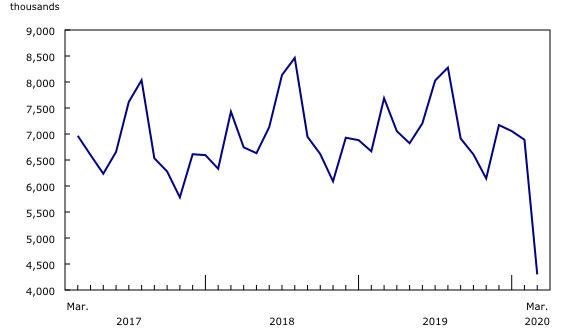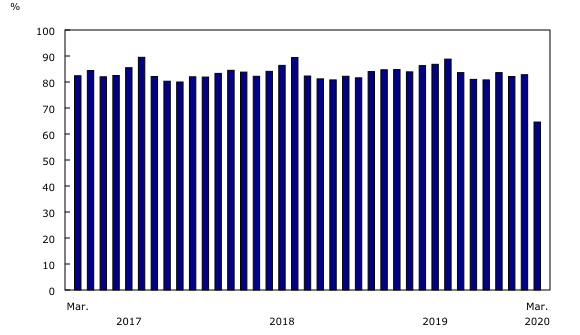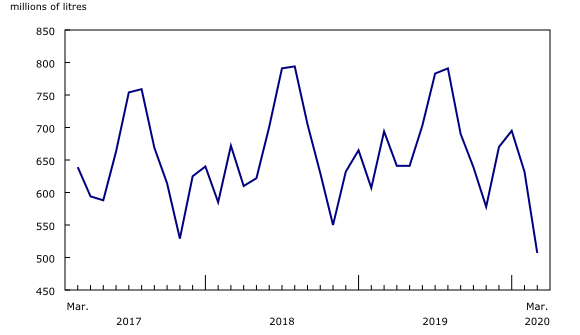Monthly civil aviation statistics, March 2020
Archived Content
Information identified as archived is provided for reference, research or recordkeeping purposes. It is not subject to the Government of Canada Web Standards and has not been altered or updated since it was archived. Please "contact us" to request a format other than those available.
Released: 2020-05-25
Highlights
The major Canadian air carriers flew 4.3 million passengers on scheduled and charter services in March 2020, down 44.1% compared with March 2019—the largest decline ever recorded in the monthly civil aviation statistics.
Similarly, air traffic dropped 45.0% in March year over year to 10.9 billion passenger-kilometres. As a result, operating revenue for these airlines totalled $1.3 billion in March, down 41.0% from the same month a year earlier.
Virus hits industry hard
On March 16, the Canadian government announced that it was closing the border to most foreign travellers, effective March 18, to limit the spread of the COVID-19 pandemic. In addition to these unprecedented travel restrictions, the Canadian airline industry felt the impact of a shuttered economy and measures such as mandated physical distancing.
Given the circumstances, some major Canadian airlines have stopped operations altogether, while others have scaled back their operations by as much as 85% to 90%. The few passenger flights that remain are mainly for repatriating Canadians stranded abroad. When airlines will fully resume passenger flights depends not only on the pace of reopening the economy, but also on the public's willingness to fly.
Discernible shift to cargo
As passenger demand does not really exist right now, some airlines have pivoted to carrying cargo. For example, WestJet has been carrying essential medical supplies, both inbound on some repatriation flights and domestically within Canada. To assist with global requirements for goods and personal protective equipment, Air Canada reported having operated more than 500 all-cargo international flights from March 22 to early May and indicated that it was planning to operate as many as 150 all-cargo flights per week in the second quarter using a combination of cargo aircraft and converted passenger planes.
Challenges abound
The airline industry faces several financial challenges, as it is generating minimal revenue but facing ongoing operating costs (e.g., aircraft maintenance and lease, reconfiguration, and debt), and it is looking for an industry-specific aid package to survive the COVID-19 pandemic.
While the full impacts of the pandemic on the industry will become clearer between April and June, the March key operating and financial metrics reflect the severity and abruptness of the impact the pandemic has had on major Canadian airlines.
The seven Canadian Level I air carriers flew 4.3 million passengers on scheduled and charter services in March, down 44.1% compared with March 2019, when there were six carriers. As a result of the travel restrictions imposed in mid-March, this is the largest single monthly decline ever recorded.
Operating revenue for these airlines totalled $1.3 billion in March, down 41.0% from the same month a year earlier.
Air traffic fell 45.0% year over year to 10.9 billion passenger-kilometres in March, while capacity declined 27.9% to 16.9 billion available seat-kilometres. This resulted in a significantly lower passenger load factor in March (64.6%) compared with the same month a year earlier (84.7%), as the decline in demand for travel was notably larger than the decrease in capacity.
On average, each passenger travelled 2,541 kilometres, down 1.6% from March 2019.
The volume of turbo fuel consumed decreased 26.9% to 507.1 million litres, while the number of flying hours fell 27.6% to 147,000 hours.
Note to readers
The Monthly Civil Aviation Survey covers all Canadian Level I air carriers: Air Canada (including Air Canada Rouge), Air Transat, Jazz, Porter, Sky Regional, Sunwing and WestJet (including Swoop, WestJet Encore and WestJet Link).
The number of air carriers increased from six in 2019 to seven in 2020, as one Level II air carrier was reclassified to Level I.
The average passenger trip length is obtained by dividing the number of passenger-kilometres by the number of passengers. Trips across Canada and across the globe are included in this calculation.
Data in this monthly release are not seasonally adjusted.
Data for March 2019 and February 2020 have been revised.
Contact information
For more information, or to enquire about the concepts, methods or data quality of this release, contact us (toll-free 1-800-263-1136; 514-283-8300; STATCAN.infostats-infostats.STATCAN@canada.ca) or Media Relations (613-951-4636; STATCAN.mediahotline-ligneinfomedias.STATCAN@canada.ca).
- Date modified:





